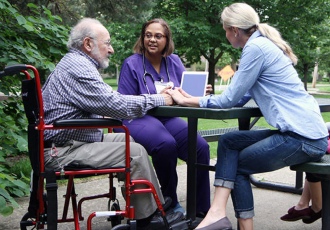By Joseph Shega, MD, Chief Medical Officer, VITAS Healthcare
Minority communities deserve the opportunity to choose respectful, accessible hospice care as they approach the end of life. But too often, they are not afforded that opportunity due to insufficient information from their healthcare professionals — and those same healthcare professionals’ hesitancy to discuss the end-of-life process with patients.
Recent research supports the imperative that physicians should educate and inform all patients about their end-of-life care options. This is especially true of those patients who may not have access to the resources needed to make a well-informed decision.
Decreases in Hospice Utilization
Hospice utilization in minority communities has decreased in recent years, according to data from the National Hospice and Palliative Care Organization. Though the COVID-19 pandemic impacted the utilization of end-of-life care for all patients, the disproportionate decrease experienced by minority communities points to other factors.
From 2019 to 2020, hospice utilization decreased by 9.4% for Hispanic Medicare beneficiaries and 5.3% for Black beneficiaries, with white beneficiaries seeing a decrease of only 3.0%.1
This leads those analyzing the findings to the question: Why is the largest decrease in hospice utilization present in minority communities?
Communication Disparities
Black patients report they are significantly less satisfied with their end-of-life care planning than white patients. Research presented at the 2022 American Society of Clinical Oncology Annual Meeting and reported on in the American Journal of Managed Care2 found that:
- 41.6% of Black patients reported dissatisfaction with physician communication, compared to 27.9% of white patients
- 63.3% of Black patients reported they received inadequate information, compared with 41.0% of white patients
Another study, conducted by a team of investigators at Albert Einstein College of Medicine, Icahn School of Medicine at Mount Sinai, and the Duke Cancer Institute, examined clinicians’ conversations with oncology patients. Researchers found that clinicians took a less empathetic approach to conversations with Black and Hispanic patients than with white patients while discussing their serious illness. The researchers also found that clinicians asked far fewer open-ended questions and elicited fewer questions from Black patients compared with white patients.2
“In this diverse sample of patients with advanced cancer, oncologists used fewer reflective statements, were less attentive to concerns, and expressed less warmth with Black, non-Hispanic patients,” the authors noted.
These experiences likely correlate with the notable decrease in hospice utilization for minority communities, resulting in very different end-of-life care satisfaction and outcomes.
Solution Through Discussion
The findings present a distinct opportunity for physicians to improve their approach to end-of-life care conversations.
Clinicians can develop the skills and confidence to engage in these conversations through clinical training programs, a more standardized approach, and practical experience. These approaches result in insightful goals-of-care conversations and more productive advance care planning.
VITAS created a Goals-of-Care Preceptorship Program to increase the comfort of healthcare professionals in initiating these vital conversations with patients. Leveraging evidence-based data and incorporating practical tools, this certificate program helps healthcare professionals approach goals-of-care conversations with well-informed confidence.
An empathetic approach is integral to ensuring that a patient feels heard and cared for, especially when addressing the topic of end-of-life care planning. This period of life is, understandably, emotionally taxing for patients and families.
Related: Strategies for Advocating and Delivering End-of-Life Care in Diverse Communities >
Remaining considerate when discussing the final stages of a patient's life is necessary to foster a mindful, constructive discussion. Compassion is a central component of everything we do at VITAS, and it is a vital part of the approaches covered in the educational opportunities we offer healthcare professionals.
Individualizing Care
Accessibility is a key component in helping patients from minority communities understand the benefits of hospice care. The Medicare Hospice Benefit covers up to 100 percent of hospice services, with no deductible or copayment for services related to the patient’s terminal illness.
Products and services in the hospice plan of care include:
- All prescription drugs, over-the-counter medications, medical equipment, and supplies related to the patient’s terminal illness and necessary for enhanced comfort, as designated in the plan of care
- If indicated for palliative purposes, physical therapy, occupational therapy, speech therapy, and dietary counseling
- Bereavement services for the family for at least one year after a loss
Whether a holiday, weekend, or the middle of the night, VITAS provides 24/7/365 clinical support, improving accessibility for patients when they need it most. VITAS Telecare service is patients’ and caregivers’ reassurance that they have a direct line to medical advice, support, and hands-on care, as appropriate, at any time.
By learning the best approaches to end-of-life care planning, educating patients on the benefits of hospice care, and remaining empathetic, healthcare professionals can help eligible patients of all communities gain access to VITAS’ clinical, spiritual, and psychosocial care.
Download our guide to end-of-life conversations to learn more >
1Hospice Facts & Figures. NHPCO. (2023, January 25). Retrieved February 3, 2023, from https://www.nhpco.org/hospice-care-overview/hospice-facts-figures/
2Shaw, M. L. (2022, July 22). Communication disparities contribute to care disparities. AJMC. Retrieved February 3, 2023, from https://www.ajmc.com/view/communication-disparities-contribute-to-care-disparities


